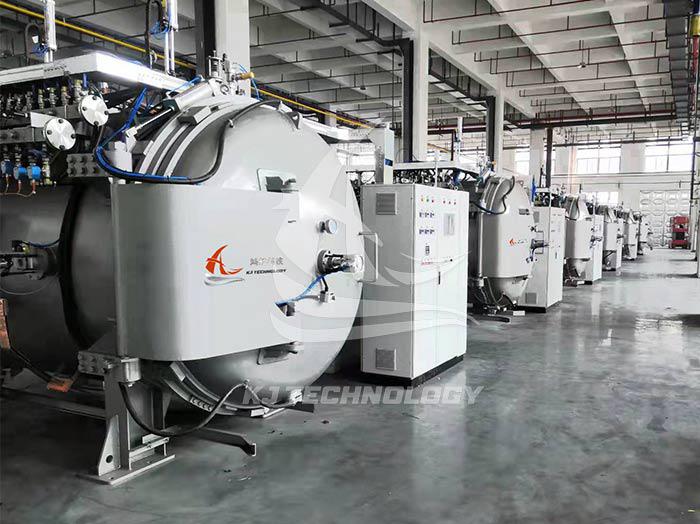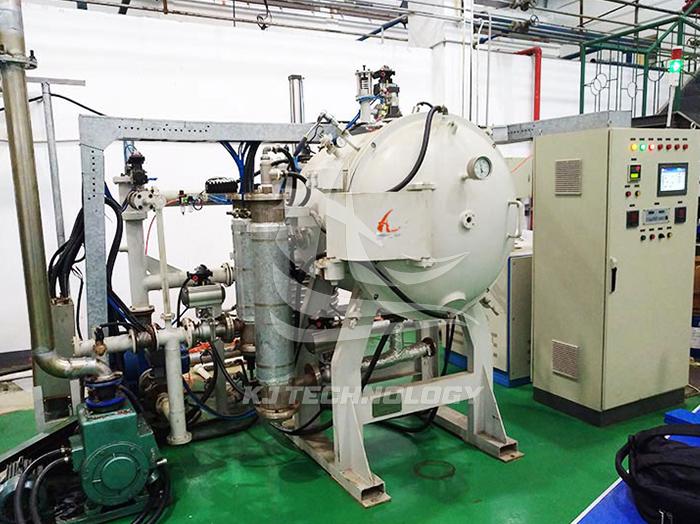Application of Vacuum Brazing Furnace in Aerospace Field
 03-21-2025 Author: KJ technology
03-21-2025 Author: KJ technology
The application of vacuum brazing furnace in the aerospace field is very extensive and crucial, mainly reflected in the following aspects:
1. Manufacturing of key components
a. Engine components
Turbine blades: Turbine blades are the core components of aircraft engines, and their manufacturing requires extremely high material performance and welding quality. The vacuum brazing furnace can achieve precise welding of turbine blades, ensuring the structural integrity and performance stability of the blades.
Heat exchanger: Heat exchangers in aircraft engines need to withstand high temperature and high pressure environments. Vacuum brazing furnaces can ensure that the welded joints of the heat exchanger have good sealing and strength, improving heat exchange efficiency.
Fuel nozzle: The manufacturing of fuel nozzles requires high-precision welding technology, and vacuum brazing furnaces can achieve precise welding of complex internal structures of the nozzle, ensuring uniform fuel injection and stable engine operation.
b. Structural component connection
Connection between fuselage and wings: High strength and high reliability connections are required between structural components such as the fuselage and wings of aerospace vehicles. The vacuum brazing furnace can achieve precise welding between these structural components, ensuring the strength and stability of the entire machine.
Skin and skeleton connection: Skin and skeleton are the main components of aerospace shells, and vacuum brazing furnaces can achieve seamless connection between them, improving the sealing and impact resistance of the shell.
2. Application of new materials
With the continuous development of aerospace technology, the application of new materials is becoming increasingly widespread. The vacuum brazing furnace can adapt to the welding requirements of different materials, such as titanium alloys, high-temperature alloys, ceramic based composite materials, etc. These new materials have excellent performance, but the welding difficulty is high. The vacuum brazing furnace can achieve reliable connection of these new materials through its unique welding environment and process parameter control.
3. Improve manufacturing efficiency and reduce costs
a. Automated production
Vacuum brazing furnaces are usually equipped with advanced automation control systems, which can achieve automated production of the welding process. This can not only improve production efficiency, but also reduce the impact of human factors on welding quality.
b. Reduce manufacturing costs
The welding process of the vacuum brazing furnace is carried out in a vacuum environment, without the need for flux or only using a small amount of environmentally friendly flux, reducing manufacturing costs. At the same time, due to the good insulation effect of the vacuum environment, energy loss is reduced, further reducing manufacturing costs.
4. Ensure product quality and reliability
a. High welding quality
The vacuum brazing furnace performs welding in a vacuum environment, effectively avoiding reactions between the workpiece and oxygen, nitrogen, etc. in the air, and reducing defects such as oxidation and nitriding. At the same time, the vacuum environment can effectively eliminate defects such as porosity and slag inclusion during the welding process, improving the quality and reliability of the welded joints.
b. Strict quality control
The aerospace industry has extremely high requirements for product quality and reliability. The vacuum brazing furnace ensures that the quality and reliability of the welded joints meet relevant standards and requirements by precisely controlling parameters such as temperature, time, and vacuum degree during the welding process.
5. Specific application cases
Foreign case: Pratt&Whitney's JT9D engine uses vacuum brazing technology to manufacture key components such as honeycomb sealing rings and fuel manifolds. These components perform excellently during engine operation, demonstrating the reliability and superiority of vacuum brazing technology in aircraft engine manufacturing.
Domestic cases: Shenyang Liming Engine Company and Chengdu Engine Company have also used vacuum brazing technology to manufacture key components of aviation engines, which have been successfully applied to naval aircraft. The manufacturing of these components not only improves the performance and reliability of engines, but also promotes the development of aviation engine manufacturing technology in China.
In summary, the application of vacuum brazing furnaces in the aerospace field has broad prospects and significant importance. With the continuous development of aerospace technology, vacuum brazing furnaces will continue to play their advantages and roles in key component manufacturing, new material applications, improving manufacturing efficiency and reducing costs, ensuring product quality and reliability, and other aspects.








